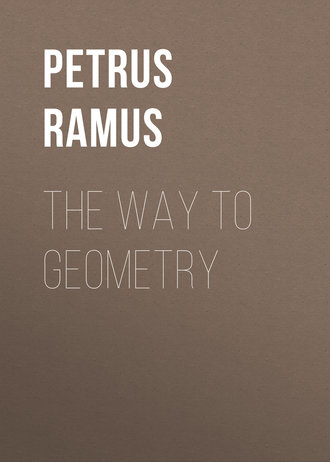 полная версия
полная версияThe Way To Geometry
For let the parts of the yard be 12. and 6. and the summe of them 18. Now as 18. is unto 12. so is the whole altitude uy, 190. foote, unto the excesse 126⅔ foote. The remainder therefore 63⅓ foote, shall be as, the lesser heighth sought.
But thou maist more fitly dispose and order this proportion thus: As ur, is unto nl: so is uo unto oy. Therefore by Arithmeticall composition, as ur, and nl, are unto nl: so uo, and oy, that is, the whole uy, is unto oy, that is, unto as. For here a subduction of the proportion, after the composition is no way necessary, by the crosse rule of societia, thus:

The second station might have beene in o, the end of the perpendicular from a. But by taking the ayme out of the toppe of the lesser altitude, the demonstration shall be yet againe more easie and short, by the two triangles at the yard aei, and aef, resembling the two whole triangles aou, and aoy, in like situation, the parts of the shanke cut, are on each side the segments of the transome.
One may againe also out of the toppe of a Turret measure the distance of two turrets one from another: For it is the first manner of measuring of longitudes, neither doth it here differ any whit from it, more than the yard is hang'd without the heighth given. The figure is thus: And the Demonstration is by the 12. e vij. For as ae, the segment of the yard, is unto ei the segment of the transome: so is the assigned altitude ao, unto the length ou.
The geodesy or measuring of altitude is thus, where either the length, or some part of the length is given, as in the first and second way: Or where the distance is double, as in the third.
17 If the sight be from the beginning of the yard being right or perpendicular, by the vanes of the transome, unto the ends of the breadth; as in the yard the difference of the segment is unto the differēce of the distance, so is the distance of the vanes unto the breadth.

The measuring of breadth, that is of a thwart or crosse line, remaineth. The Figure and Demonstration is thus: The first ayming, let it be aei, by o, and u, the vanes of the transome ou. The second, let it be yei, by s, and r, the vanes of the transome sr. Then by the point s, let the parallell lsm, be drawne against aoe. Here first, the triangles oua, and sil, are equilaters, by the 2 e vij. Because the angles at n and j, are right angles: And uao, and jls, the outter and inner, are equall in their bases ou, and sj, by the grant: Because here the segment of the transome remaineth the same: Therefore ua, is equall to jl. These grounds thus laid, the demonstration of the third altitude here taken place. For as yl, is unto ya: so is sj, unto er: And, because parts are proportionall unto their multiplicants, so is sr, unto ei: for the rest doe agree.
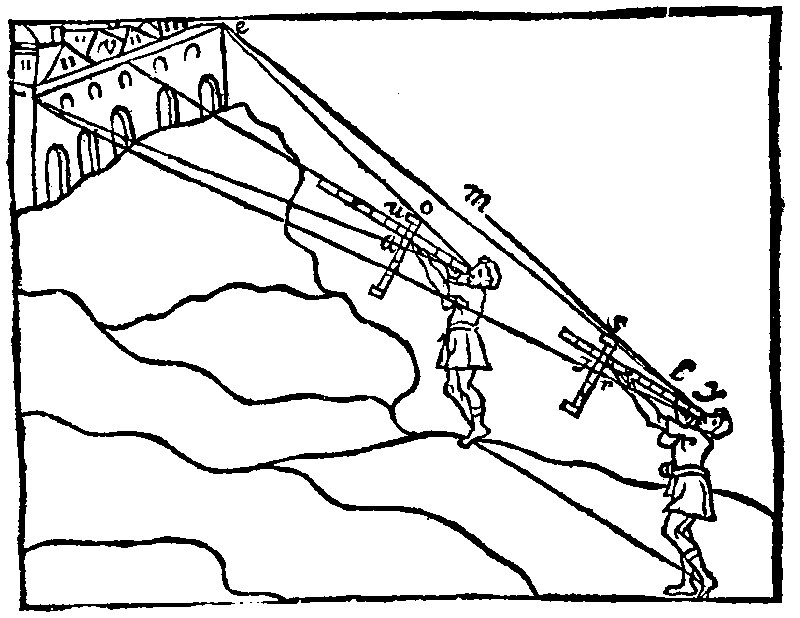
The same shall be the geodesy or manner of measuring, if thou wouldest from some higher place, measure the breadth that is beneath thee, as in the last example. But from the distance of two places, that is, from latitude or breadth, as of Trees, Mountaines, Cities, Geographers and Chorographers do gaine great advantages and helpes.
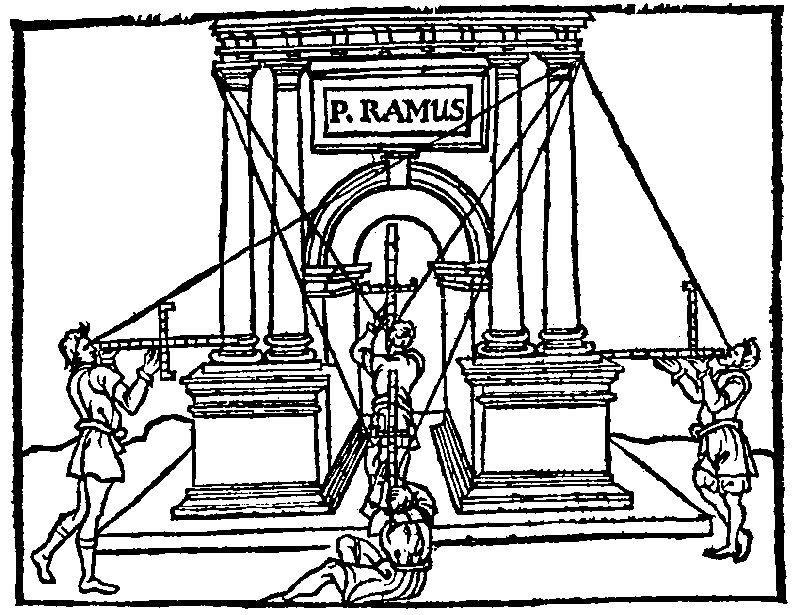
Wherefore the geodesy or measuring of right lines is thus in length, heighth, and breadth, from whence the Painter, the Architect, and Cosmographer, may view and gather of many famous place the windowes, the statues or imagery, pyramides, signes, and lastly, the length and heighth, either by a single or double: the breadth by a double dimension onely, that is, they may thus behold and take of all places the nature and symmetry; as in the example next following thou mayst make triall when thou pleasest.
The tenth Booke of Geometry, of a Triangulate and Parallelogramme
And thus much of the geodesy of right lines, by the meanes of rectangled triangles: It followeth now of the triangulate.
1. A triangulate is a rectilineall figure compounded of triangles.
As before (for the dichotomies sake) of a line was made a Lineate, to signifie the genus of surface and a Body: so now is for the same cause of a triangle made a Triangulate, to declare and expresse the genus of a Quadrilater and Multilater, and indeed more justly, then before in a Lineate. For triangles doe compound and make the triangulate, but lines doe not make the lineate.
Therefore
2. The sides of a triangulate are two more than are the triangles of which it is made.

As the sides of a Quadrangle are 4. Therefore the triangles which doe make the same foure-sided figure are but 2. The sides of a Quinquangle are 5, Therefore the triangles are 3, and so forth of the rest, as here thou seest. And that indeed is the least: For even a triangle it selfe, may be cut into as many triangles as one please.
That both the inner and outter are equall to right angles, in every kinde of right line figure, it was manifest at the 4 e vj. The inner in a Quadrangle, are equall to 4. In a Quinquangle, to 6: In an Hexangle, to 8; and so forth.
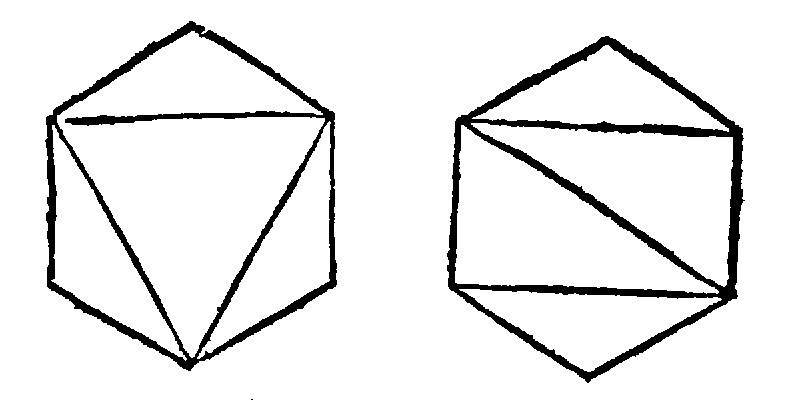
But the outter, in every right-lined figure, are equall to 4 right angles: as here may be demonstrated, by the 14 e v and 13 e vj.
And
3. Homgeneall Triangulates are cut into an equall number of triangles, è 20 p vj.
For if they be Quadrangles, they be cut into two triangles: If Quinquangles, into 3. If Hexangles, into 4, and so forth.
4. Like triangulates are cut into triangles alike one to another and homologall to the whole è 20 p vj.
Or thus: Like Triangulates are divided into triangles like one unto another, and in porportion correspondent unto the whole: H.
As in these two quinquangles. First the particular triangles are like betweene themselves. For the shankes of aeu and ysm, equall angles are proportionall, by the grant. Therefore the triangles themselves are equiangles, by 14 e vij. And therefore alike, by the 12 e vij, and so forth of the rest.

The middle triangles, the equall angles being substracted shall have their other angles equall: And therefore they also shall be equiangles and alike, by the same.
Secondarily, the triangles aeu. and ysm: eio and srl; eou, and slm, to wit, alike betweene themselves, are by the 1 e vj, in a double reason of their homologall sides eu, sm, eo, sl, which reason is the same, by meanes of the common sides. Therefore three triangles are in the same reason: And therefore they are proportionall: And, by the third composition, as one of the antecedents is, unto one of the consequents; so is the whole quinquangle to the whole.
5. A triangulate is a Quadrangle or a Multangle.
The parts of this partition are in Euclide, and yet without any shew of a division. And here also, as before, the species or severall kinds have their denomination their angles, although it had beene better and truer to have beene taken from their sides; as to have beene called a Quadrilater, or a Multilater. But in words use must bee followed as a master.
6. A Quadrangle is that which is comprehended of foure right lines. 22 d j.
As here thou seest. But a Quadrangle may also bee a sphearicall, and a conicall, and a cylindraceall, and that those differences are common, we doe foretell at the 3 e v. And a Quadrangle may be a plaine, which is not a quadrilater, as here.

7. A quadrangle is a Parallelogramme, or a Trapezium.
This division also in his parts is in the Elements of Euclide, but without any forme or shew of a division. But the difference of the parts shall more fitly be distinguished thus: Because in generall there are many common parallels.
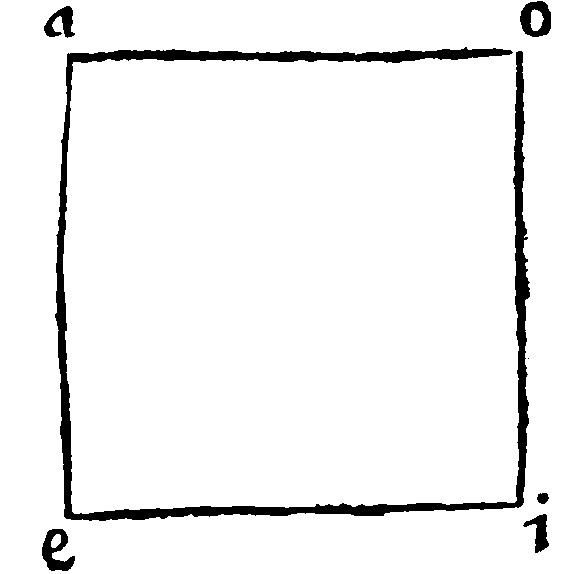
8. A Parallelogramme is a quadrangle whose opposite sides are parallell.
As in the example, the side ae, is parallell to the side io: And the side ei, is parallell to opposite side ao.
Therefore
9. If right lines on one and the same side, doe joyntly bound equall and parallall lines, they shall make a parallelogramme.
The reason is, because they shall be equall and parallell betweene themselves, by the 26. e v.
And
10 A parallelogramme is equall both in his opposite sides, and angles, and segments cut by the diameter.
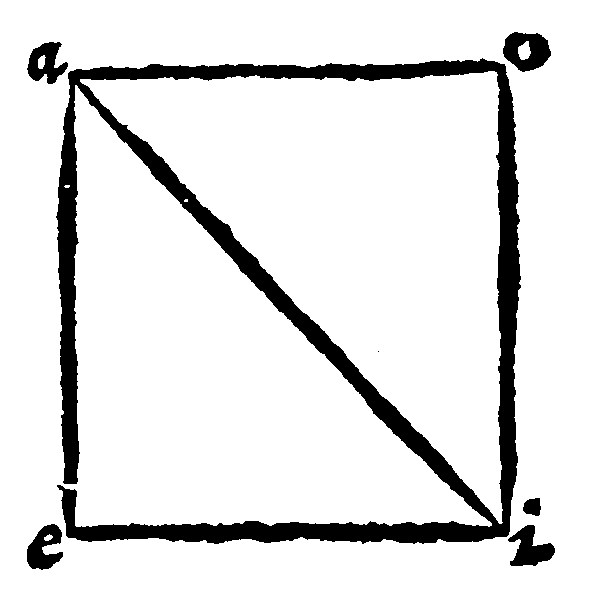
Or thus: The opposite, both sides, and angles, and segments cut by the diameter are equall. Three things are here concluded: The first is, that the opposite sides are equall: This manifest by the 26 e v. Because two right lines doe jointly bound equall parallells.
The second, that the opposite angles are equall, the Diagonall ai, doth shew. For it maketh the triangles aei, and ioa, equilaters: And therefore also equiangles: And seeing that the particular angles at a, and i, are equall, the whole is equall to the whole. This part is the 34. p j;

The third: The segments cut by the diameter are alwayes equall, whether they be triangles, or any manner of quadrangles, as in the figures. For the Diameter doth cut into two equall parts, the parallelogramme by the Angles, or by the opposite sides, or by the alternall equall segments of the sides.
And
11. The Diameter of a parallelogramme is cut into two by equall raies.
As in the three figures aei, next before: This a parallelogramme hath common with a circle, as was manifest at the 28. e iiij.
And

12 A parallelogramme is the double of a triangle of a trinangle of equall base and heighth, 41. p j.
The comparison first in rate of inequality of a parallelogramme with a triangle, doth follow: As here thou seest in this diagramme. For a parallelogramme is cut into two equall triangles, by the antecedent. Therefore it is the double of the halfe.
And
13 A parallelogramme is equall to a triangle of equall heighth and double base unto it: è 42. p j.
As to aei, the triangle, the parallelogramme aoiu, is equall: because halfe of the parallelogramme is equall to the triangle: Therefore the halfes being equall, whole also shall be equall.
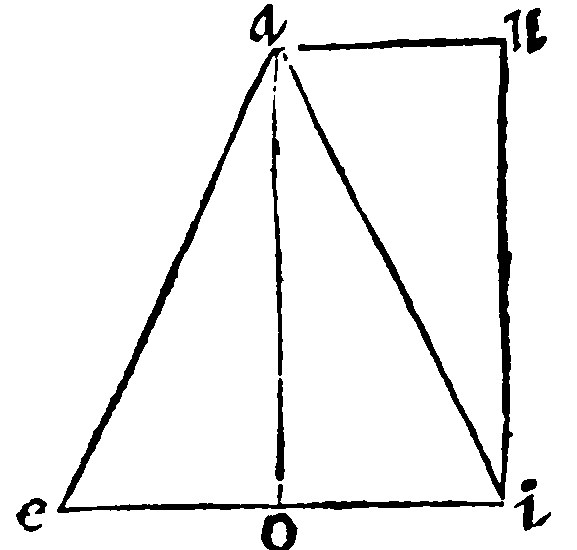
From whence one may
14 To a triangle given, in a rectilineall angle given, make an equall parallelogramme.
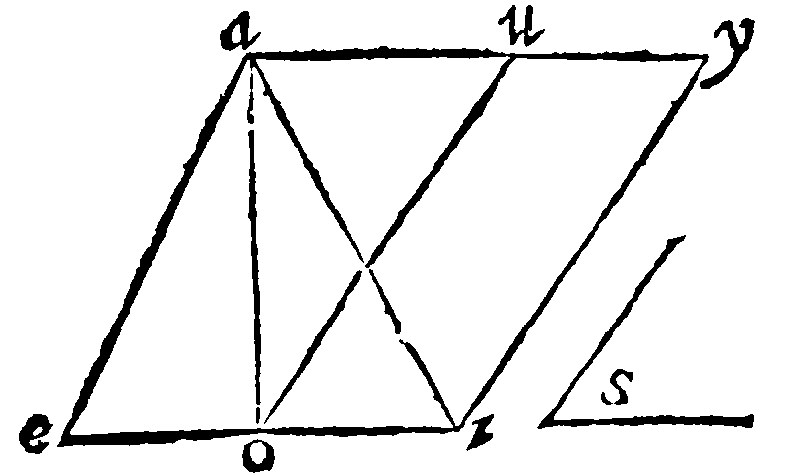
As here to the triangle, aei, given in s, the right lined angle given, you may equall the parallelogramme ouyi.
15 A parallelogramme doth consist both of two diagonals, and complements, and gnomons.
For these three parts of a parallelogramme are much used in Geometricall workes and businesses, and therefore they are to be defined.
16 The Diagonall is a particular parallelogramme having both an angle and diagonall diameter common with the whole parallelogramme.

First the Diagonall is defined: As in the whole parallelogramme aeio, the diagonals are auys, and ylir; Because they are parts of the whole, having both the same common angles at a, and i: and diagonall diameter ai, with the whole parallelogramme: Not that the whole diagonie is common to both: But because the particular diagonies are the parts of the whole diagony. Therefore the diagonalls are two.
17 The Diagonall is like, and alike situate to the whole parallelogramme: è 24. p vj.
There is not any, either rate or proportion of the diagonall propounded, onely similitude is attributed to it, as in the same figure, the Diagonall auys, is like unto the whole parallelogramme aeio. For first it is equianglar to it. For the angle at a, is common to them both: And that is equall to that which is at y, (by the 10. e x:) And therefore also it is equall to that at i by the 10. e x. Then the angles auy, and asy, are equall, by the 21. e v. to the opposite inner angles at e, and o. Therefore it is equiangular unto it.
Againe, it is proportionall to it in the shankes of the equall angles. For the triangles auy, and aei, are alike, by the 12 e vij, because uy is parallell to the base. Therefore as au is uy; so is ai to ei: Then as uy is to ya; so is ei to ia. Againe by the 21 e v, because sy is parallell to the base io, as ay is to ys: so is ai, to io: Therefore equiordinately, as uy is to ys: so is ei to io: Item as sy is to ya, so is io to ia: And as ya is to as: so is ia to ao. Therefore equiordinately, as ys is to sa: so is io to oa. Lastly as sa is unto ay; so is oa unto ai: And as ay is to au; so is ai unto ae. Therefore equiordinately, as sa is to au: so is ao, to ae. Wherefore the Diagonall su is proportionall in the shankes of equall angles to the parallelogramme oe.
The demonstration shall be the same of the Diagonall rl. The like situation is manifest, by the 21 e iiij. And from hence also is manifest, That the diagonall of a Quadrate, is a Quadrate: Of an Oblong, an Oblong: Of a Rhombe, a Rhombe: Of a Rhomboides, a Rhomboides: because it is like unto the whole, and a like situate.
Now the Diagonalls seeing they are like unto the whole and a like situate, they shall also be like betweene themselves and alike situate one to another, by the 21 and 22 e iiij.
Therefore
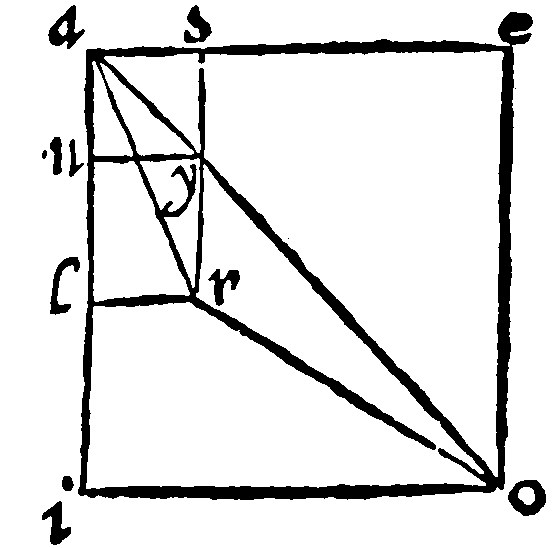
18. If the particular parallelogramme have one and the same angle with the whole, be like and alike situate unto it, it is the Diagonall. 26 p vj.
This might have beene drawn, as a consectary, out of the former: But it may also as it is by Euclide be forced, by an argument ab impossibili. For otherwise the whole should be equall to the part, which is impossible.
As for example, Let the particular parallelogramme auys, be coangular to the whole parallelogramme aeio; And let it have the same angle with it at a; like unto the whole and alike situate unto it; I say it is the Diagonall.
Otherwise, let the diverse Diagony be aro: And let lr be parallell against ae: Therefore alrs, shall bee the Diagonall, by the 6 e [16.] Now therefore it shall be, by 8 e [17 e,] as ea is to ai: so is sa unto al: Againe,by the grant, as ea is unto ai: so is sa to au: Therefore the same sa is proportionall to al, and to au: And al is equall to au, the part to the whole, which is impossible.
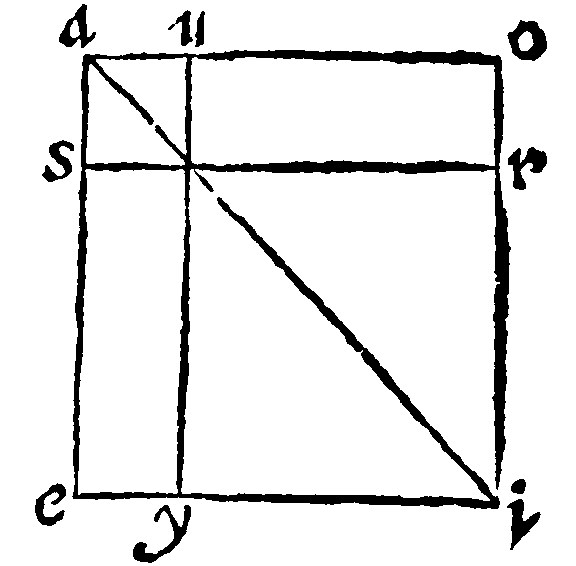
19. The Complement is a particular parallelogramme, comprehended of the conterminall sides of the diagonals.
Or thus: It is a particular parallelogramme conteined under the next adjoyning sides of the diagonals.
As in this figure, are ur, and sy: For each of them is comprehended of the continued sides of the two diagonals. And therefore are they called Complements, because they doe with the Diagonals complere, that is, fill or make up the whole parallelogramme. Neither in deed may the two diagonals be described, but withall the complements must needes be described.
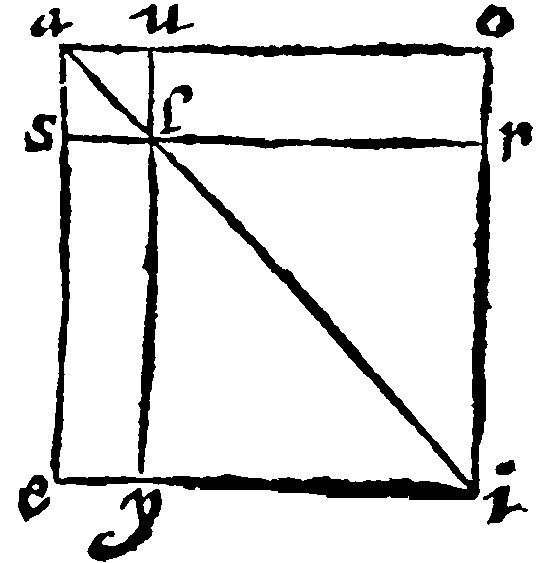
20. The complements are equall. 43 p j.
As in the same figure, are the sayd ur, and sr: For the triangles aei, and aoi, are equall, by the 12 e. Item, so are asl, and aul: Item, so are lui, and lri. Therefore if you shall on each side take away equall triangles from those which are equall, you shall leave the Complements equall betweene themselves.
Therefore
21. If one of the Complements be made equall to a triangle given, in a right-lined angle given, the other made upon a right line given shall be in like manner equall to the same triangle. 44 p j.

As if thou shouldest desire to have a parallelogramme upon a right line given, and in a right lined angle given, to be made equall to a triangle given, this proposition shall give satisfaction.
Let aei be the Triangle given: The Angle be o: And the right line given be iu: And the Parallelogramme ay is equall to aei, triangle given in the angle assigned, by the 13 e. Then let the side ay, bee continued to r, equally to iu, the line given: And let ru be knit by a right line: And from r drawne out a diagony untill it doe meete with as, infinitely continued; which shall meete with it, by the 19 e v, in l. And the sides yi, and ru, let them be continued equally to sl. in m and n. And knit ln together with a right line. This complement mu, is equall to the complement ys, which is equall to the Triangle assigned, by the former, and that in a right lined angle given.
And
22 If parallelogrammes be continually made equall to all the triangles of an assigned triangulate, in a right lined angle given, the whole parallelogramme shall in like manner be equall to the whole triangulate. 45 p j.
This is a corollary of the former, of the Reason or rate of a Parallelogramme with a Triangulate; and it needeth no farther demonstration; but a ready and steddy hand in describing and working of it.

Take therefore an infinite right line; upon the continue the particular parallelogrammes, As if the Triangulate aeiou, were given to be brought into a parallelogramme: Let it be resolved into three triangles, aei, aio, and aou: And let the Angle be y: First in the assigned Angle, upon the Infinite right line, make by the former the Parallelogramme ae, in the angle assigned, equall to aei, the first triangle. Then the second triangle, thou shalt so make upon the said Infinite line, that one of the shankes may fall upon the side of the equall complement; The other be cast on forward, and so forth in more, if neede be.
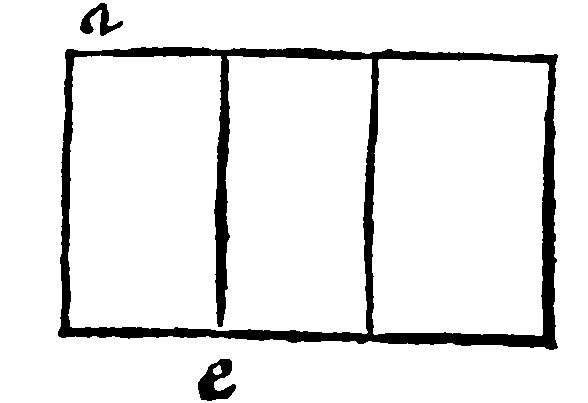
Here thou hast 3 complements continued, and continuing the Parallelogramme: But it is best in making and working of them, to put out the former, and one of the sides of the inferiour or latter Diagonall, least the confusion of lines doe hinder or trouble thee.
Therefore
23. A Parallelogramme is equall to his diagonals and complements.
For a Parallelogramme doth consist of two diagonals, and as many complements: Wherefore a Parallelogramme is equall to his parts: And againe the parts are equall to their whole.
24. The Gnomon is any one of the Diagonall with the two complements.
There is therefore in every Parallelogramme a double Gnomon; as in these two examples. Of all the space of a parallelogramme about his diameter, any parallelogramme with the two complements, let it be called the Gnomon. Therefore the gnomon is compounded, or made of both the kindes of diagonall and complements.
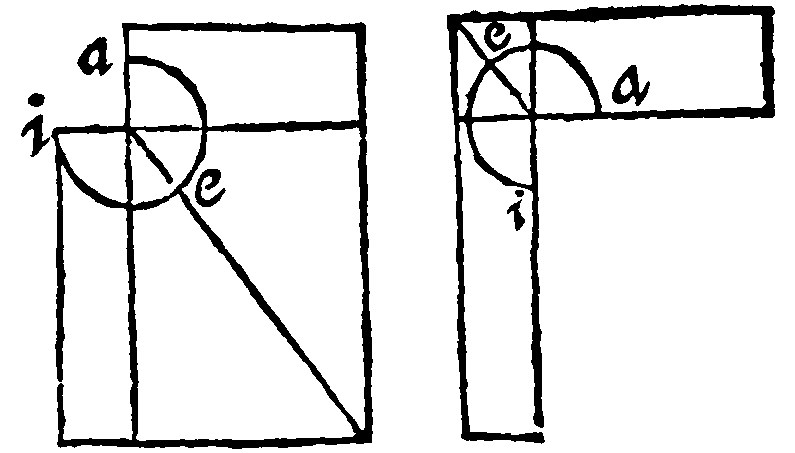
In the Elements of Geometry there is no other use, as it seemeth of the gnomons than that in one word three parts of a parallelogramme might be signified and called by three letters aei. Otherwise gnomon is a perpendicular.
25. Parallelogrames of equall height are one to another as their bases are. 1 p vj.
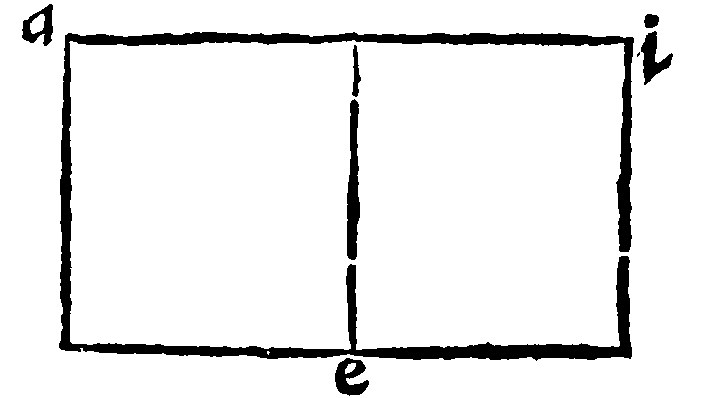
As is apparent, by the 16 e iiij. Because they be the double of Triangles, by the 12 e, of first figures: As ae, and ei.
Therefore
26 Parallelogrammes of equall height upon equall bases are equall. 35. 36 pj.
As is manifest in the same example.
27 If equiangle parallelogrammes be reciprocall in the shankes of the equall angle, they are equall: And contrariwise. 15 p vj.
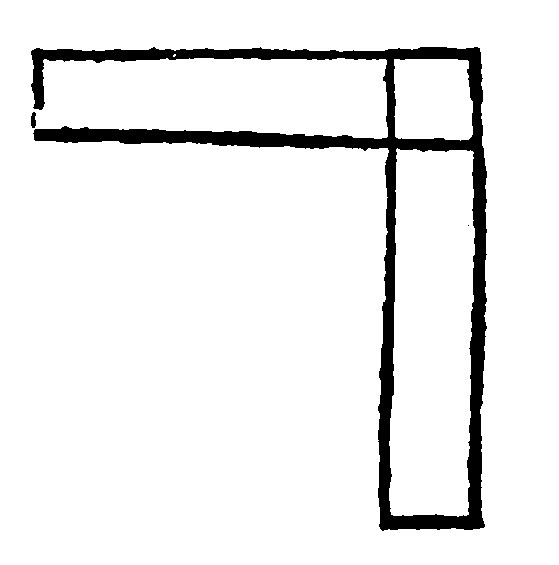
It is a consectary drawne out of the 11 e vij: As here thou seest: And yet indeed both that (as there was sayd) and this is rather a consectary of the 18 e iiij, which here also is more manifest.
Therefore
28 If foure right lines be proportionall, the parallelogramme made of the two middle ones, is equall to the equiangled parallelogramme made of the first and last: And contrariwise, e 16 p vj.
For they shall be equiangled parallelogrammes reciprocall in the shankes of the equall angle.
And
29 If three right lines be proportionall, the parallelogramme of the middle one is equall to the equiangled parallelogramme of the extremes: And contrariwise.
It is a consectary drawne out of the former.
Of Geometry, the eleventh Booke, of a Right angle
1. A Parallelogramme is a Right angle or an Obliquangle.
Hitherto we have spoken of certaine common and generall matters belonging unto parallelogrammes: specials doe follow in Rectangles and Obliquangles, which difference, as is aforesaid, is common to triangles and triangulates. But at this time we finde no fitter words whereby to distinguish the generals.



